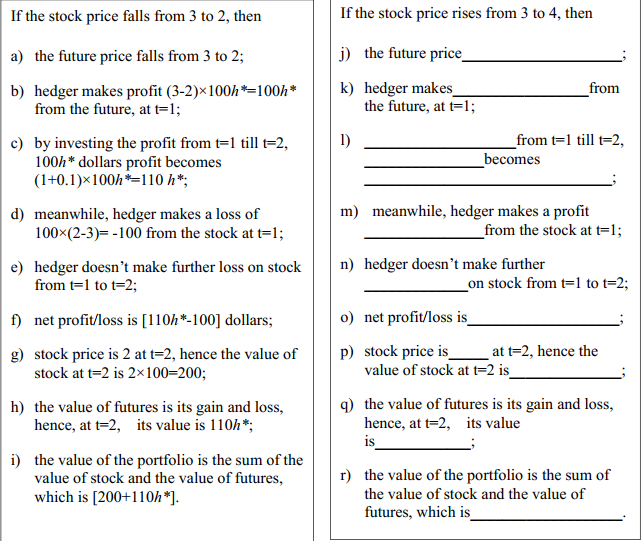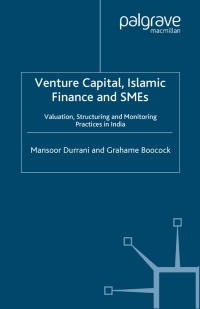Answered step by step
Verified Expert Solution
Question
1 Approved Answer
1. Assume hedger takes hedge ratio as h*, i.e, if the risk exposure is a long position of 100 units of spot commodity, to hedge

1. Assume hedger takes hedge ratio as h*, i.e, if the risk exposure is a long position of 100 units of spot commodity, to hedge the risk, hedger will short 100h* futures underlying on that commodity. Please answer the questions in the right panel in analogy to the left panel, by filling the blanks in j) r) below:

2. To make the hedge portfolio risk-free, the value of the portfolio should not vary no matter stock price rises or falls. Please based on the above fact, solve the optimal hedge ratio h*.
t=0 t=1 t=2 Pu=0.5 F1,2=4 F2,294 F0,2=3 F1,2=2 F2,2=2 Pd=0.5 If the stock price falls from 3 to 2, then If the stock price rises from 3 to 4, then j) the future price k) hedger makes the future, at t=1; from 1) from t=1 till t=2, _becomes a) the future price falls from 3 to 2; b) hedger makes profit (3-2)x100h*=100h* from the future, at t=1; c) by investing the profit from t=1 till t=2, 100h* dollars profit becomes (1+0.1)*100he=110 h*; d) meanwhile, hedger makes a loss of 100%(2-3)=-100 from the stock at t=1; e) hedger doesn't make further loss on stock from t=1 to t=2; f) net profit/loss is [110,*-100] dollars; g) stock price is 2 at t=2, hence the value of stock at t=2 is 2*100=200; h) the value of futures is its gain and loss, hence, at t=2, its value is 110h*; i) the value of the portfolio is the sum of the value of stock and the value of futures, which is [200+110h*]. m) meanwhile, hedger makes a profit _from the stock at t=1; n) hedger doesn't make further on stock from t=1 to t=2; 0) net profit/loss is p) stock price is at t=2, hence the value of stock at t=2 is_ q) the value of futures is its gain and loss, hence, at t=2, its value is r) the value of the portfolio is the sum of the value of stock and the value of futures, which is t=0 t=1 t=2 Pu=0.5 F1,2=4 F2,294 F0,2=3 F1,2=2 F2,2=2 Pd=0.5 If the stock price falls from 3 to 2, then If the stock price rises from 3 to 4, then j) the future price k) hedger makes the future, at t=1; from 1) from t=1 till t=2, _becomes a) the future price falls from 3 to 2; b) hedger makes profit (3-2)x100h*=100h* from the future, at t=1; c) by investing the profit from t=1 till t=2, 100h* dollars profit becomes (1+0.1)*100he=110 h*; d) meanwhile, hedger makes a loss of 100%(2-3)=-100 from the stock at t=1; e) hedger doesn't make further loss on stock from t=1 to t=2; f) net profit/loss is [110,*-100] dollars; g) stock price is 2 at t=2, hence the value of stock at t=2 is 2*100=200; h) the value of futures is its gain and loss, hence, at t=2, its value is 110h*; i) the value of the portfolio is the sum of the value of stock and the value of futures, which is [200+110h*]. m) meanwhile, hedger makes a profit _from the stock at t=1; n) hedger doesn't make further on stock from t=1 to t=2; 0) net profit/loss is p) stock price is at t=2, hence the value of stock at t=2 is_ q) the value of futures is its gain and loss, hence, at t=2, its value is r) the value of the portfolio is the sum of the value of stock and the value of futures, which isStep by Step Solution
There are 3 Steps involved in it
Step: 1

Get Instant Access to Expert-Tailored Solutions
See step-by-step solutions with expert insights and AI powered tools for academic success
Step: 2

Step: 3

Ace Your Homework with AI
Get the answers you need in no time with our AI-driven, step-by-step assistance
Get Started


